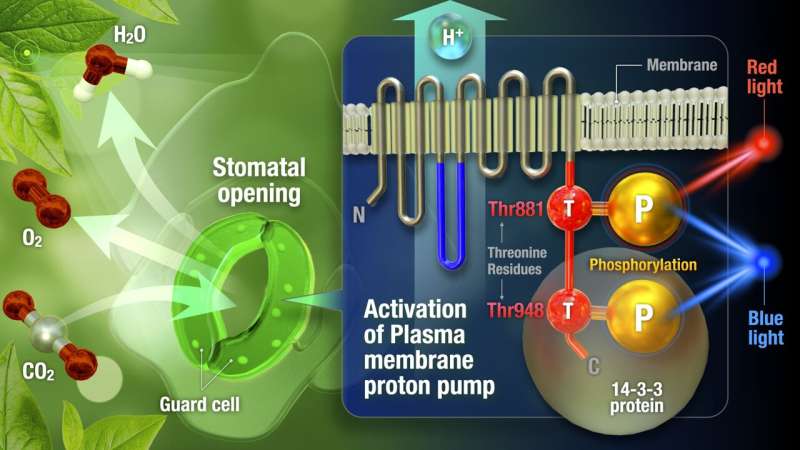This article has been reviewed according to Science X's editorial process and policies. Editors have highlighted the following attributes while ensuring the content's credibility:
fact-checked
peer-reviewed publication
trusted source
proofread
Discovery of amino acid unveils how light makes stomata open in plants

Scientists from Nagoya University have discovered a novel regulatory mechanism that controls the opening of stomata in plants, which is crucial for harnessing solar energy through photosynthesis. The team uncovered the role of phosphorylation at the 881st threonine residue (Thr881) of the plasma membrane proton pump in response to red and blue light in this process.
This research opens up possibilities for manipulating plant physiology in specific ways, benefiting agriculture and the environment. The researchers reported their findings in Nature Communications.
"This phosphorylation event, previously unknown, activates the proton pump, facilitating stomatal opening and enhancing photosynthetic activity," senior researcher Toshinori Kinoshita said. "The findings shed light on the intricate signaling pathways underlying plant responses to light and hold promise for future applications in plant engineering."
Stomata are microscopic pores on the surface of plant leaves. They play a crucial role in gas exchange by regulating the uptake of carbon dioxide essential for photosynthesis.
Understanding the molecular mechanisms that govern stomatal opening in response to environmental signals, such as light, is fundamental to plant physiology and cultivation. Recent advances in understanding stomatal opening have increased the growth and yields of important crop plants.
A key part of this process is phosphorylation of amino acids, especially Thr. Phosphorylation is adding or removing a phosphate group from an amino acid using an enzyme. It acts like an on/off switch, altering the structure and function of the protein depending on whether the phosphate is present.
Researchers from the Institute for Transformative Biomolecules (WPI-ITbM) and the Graduate School of Science at Nagoya University collaborated to investigate the role of an amino acid, Thr881. They employed extensive phosphoproteomic analysis on protoplasts derived from cells of thale cress (Arabidopsis thaliana).
The phosphorylation of Thr881 was observed in response to both red and blue light conditions. The dual activation mechanism, which relies on both photosynthesis and the blue light receptor phototropin, emphasizes the complex interaction between light signaling and physiological responses in plants.
Further investigations using Arabidopsis thaliana mutants confirmed the essential role of Thr881 phosphorylation in stomatal opening. When they made plants expressing a mutant proton pump lacking Thr881 phosphorylation, they found reduced stomatal aperture and transpiration rates, underscoring the significance of this regulatory mechanism.
They concluded that Thr-881 of the membrane protein AHA1, together with Thr-948, was phosphorylated in response to blue light. Phosphorylation of both Thr-881 and Thr-948 is crucial for activation of the enzyme H+ -ATPase, which allows stomatal opening.
"Through this research, we have been able to identify a crucial amino acid responsible for the activation of the plasma membrane proton pump," Kinoshita said. "By modifying the amino acid, we can potentially control stomatal opening."
The researchers also observed Thr881 phosphorylation in leaves and shoots, indicating that it plays a broader role in plant physiology beyond regulating stomata.
"The plasma membrane proton pump functions in all plant cells, playing a vital role not only in the opening of the stomatal gland but also in the uptake of nutrients in the roots, the transport of photosynthetic products, and pollen tube elongation," Kinoshita said.
"This suggests that the manipulation of Thr881 could contribute to promoting plant growth, increasing carbon dioxide absorption, and reducing the use of fertilizers such as nitrogen and phosphorus."
More information: Yuki Hayashi et al, Phosphorylation of plasma membrane H+-ATPase Thr881 participates in light-induced stomatal opening, Nature Communications (2024). DOI: 10.1038/s41467-024-45248-5
Journal information: Nature Communications





















